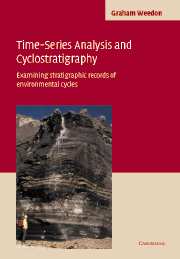Book contents
- Frontmatter
- Contents
- Preface
- Acknowledgements
- Chapter 1 Introduction
- Chapter 2 Constructing time series in cyclostratigraphy
- Chapter 3 Spectral estimation
- Chapter 4 Additional methods of time-series analysis
- Chapter 5 Practical considerations
- Chapter 6 Environmental cycles recorded stratigraphically
- Appendix – published algorithms for time-series analysis
- References
- Index
Chapter 4 - Additional methods of time-series analysis
Published online by Cambridge University Press: 13 August 2009
- Frontmatter
- Contents
- Preface
- Acknowledgements
- Chapter 1 Introduction
- Chapter 2 Constructing time series in cyclostratigraphy
- Chapter 3 Spectral estimation
- Chapter 4 Additional methods of time-series analysis
- Chapter 5 Practical considerations
- Chapter 6 Environmental cycles recorded stratigraphically
- Appendix – published algorithms for time-series analysis
- References
- Index
Summary
Introduction
This chapter is principally concerned with techniques for analysing regular cyclicity previously detected via spectral analysis (Chapter 3). However, wavelet analysis, phase portraits and singular spectrum analysis discussed here can be used meaningfully prior to generating a power spectrum. In this, and subsequent chapters, the power spectra were obtained using the multi-taper method with confidence levels from robust AR(1) modelling following the procedure of Mann and Lees (1996). As for Chapters 2 and 3, sources of computer algorithms are listed in the Appendix.
Evolutionary spectra
It is often difficult to be sure whether a time series is stationary in terms of the variance (Section 3.2.2). Power spectra indicate the average variance density versus frequency for the whole time series and this may give a misleading impression of the data. Clearly, if regular cyclicity of a particular wavelength is sought, it is important to be sure that it has a large amplitude throughout the data set (in this case meaning an amplitude that is significantly different from the background levels). A simple test can be performed, by generating spectra for the two halves of the time series, and then checking for the persistence of a spectral peak at the expected frequency. A disadvantage of this method is that the bandwidth of the two subspectra is double that of the spectrum for the whole record.
- Type
- Chapter
- Information
- Time-Series Analysis and CyclostratigraphyExamining Stratigraphic Records of Environmental Cycles, pp. 91 - 128Publisher: Cambridge University PressPrint publication year: 2003
- 2
- Cited by



